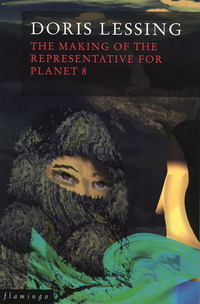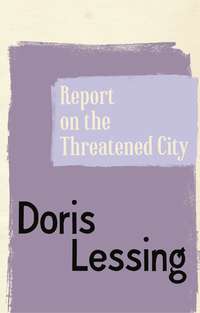
Полная версия
The Sirian Experiments
These females regarded themselves as favoured and privileged: indeed they were. They knew themselves to be of superb physical fitness and condition. They had been told by the highest among our Colonial Service, which is itself the highest function of our Empire, how much their services were valued. But in spite of all this, we knew a degree of watchfulness had to be maintained: this, the reproductive instinct, being the strongest there is, it could take – had taken, in the past – many surprising forms; and we did not want any of them escaping with their young when the time came to give them up. For they all knew that this must be when the young had attained five R-years.
This was one reason the breeding station was on Rohanda, which was a long way from our Mother Planet and visited by none except our craft and those of Canopus. (Or so we believed then – but of that later.) It would not be possible for them to escape either by spacecraft or out of the Lombi plain, for there were guards stationed all around a vast periphery, well out of sight, who had been trained in every manifestation of the maternal instinct in desperation.
The other reason this station was here, well out of the way, was that such experiments always aroused opposition. This phenomenon is so well known that I will do no more than draw attention to it. Even when females have volunteered for this type of service, even when the experiments are crowned with success, and the results are shown in new breeds and strains that fulfil everything expected of them and are heaped with honours, and whose functioning is remarked and followed with approval and admiration from everywhere in our Empire – even so there is criticism, and of a certain kind, which I have learned to recognize. It is always marked by a sharp painful note, or tone, that signals a feeling of loss – and not only a personal loss, not at all: this is why I for one have always taken pains to notice this cry, or protest, which is so much more than personal. I can only put it like this: that it seems as if – I do not see how we can conclude anything else – when such deliberate, controlled experiments take place, to produce definitely envisaged stocks or strains, it is felt – most deeply and profoundly, and by the most responsible and evolved of our peoples – that some other possibility may have been lost.
As if randomness and chance in themselves are a good and a blessing and even a means of acquiring something not yet defined … I am stating my own personal opinion here, arrived at after much reflection.
This was the largest experiment in eugenics ever undertaken by us. Its success was due not least to the Rohandan atmosphere, the Rohandan isolation from other influences, our distance from the centre. When the fifty R-years of the experiment were over, and the breeding station finally dismantled, we congratulated ourselves that in that time not one of the successive inputs of females had escaped, and that we had not again contributed to the Rohandan species.
For five thousand R-years we did not investigate conditions in the northern Canopean areas: it will be remembered that we believed we had before us millions of years of a stable environment. We were informed that Canopus was sending a special mission, as they had reason to believe their plans were more successful than had been envisaged. The report of this mission was sent to us: it recommended the immediate implementation of something they called a ‘Lock’.
Again it has to be emphasized that we did not understand the bases of the Canopean work. We did not know what this ‘Lock’ was: though this did not mean we were not aware that there was regular contact between Canopus and Rohanda. But we assumed this was on the lines of the various types of electrical communication used by us with our own planets near enough for these methods. They also talked about ‘a degenerative disease’, but without specification. These two concepts were not understood by us at all, until recently: are not understood now generally. We might have asked questions: Canopus was always ready to answer them. We might have asked ourselves questions, since we believed our technology was as advanced as that of Canopus. But we did not. The reason was the same: various forms of pride. What was in the body of the report inflamed us with disbelief and suspicion.
The natives who still enjoyed their well-supervised and comfortable lives so close to us were nowhere near the level described in the report on the northern hemisphere.
We had chosen disbelief – but not entirely, for again I decided on some investigations of our own.
It happened that at that time Ambien I was visiting me.
In our long distant early youth we had been aligned for the purpose of producing our allotted four progeny – that was before the reduction of general population levels. Ambien I had decided after our progeny were grown to enter into another alignment with a female who subsequently worked with me on various projects when we had reached general-service-age. The eight products of the two alignments had formed bonds of various kinds and, in short, the personal aspects of our lives had been satisfactory.
Ambien I had been on the committee that first considered what our work would be on Rohanda, and had been involved with it ever since. His visit to me was partly old friendship and partly investigative: I had not been back to our Home Planet for millennia: this was because I was thoroughly happy on Rohanda, enjoyed my work, and thought it too pleasant a place to abandon for service leave. Members of the Colonial Service, even members of the Five, visiting us for any reason always made excuses to stay. In short, Rohanda had become my home.
When we had had time to satisfy our accumulated curiosity about each other’s doings, after what had been a good lapse of time, I asked him if he would undertake a spying mission to the northern areas. He agreed readily. More than once he had been in the teams that ‘opened up’ new planets, and he had always enjoyed this type of rough dangerous work. We did not expect danger from this particular enterprise, but at least it would be a break from routine. He took a liaison ship to the extreme south of the central landmass, where he dismissed it. Altogether he was away ten R-years.
He travelled extensively over the central landmass, where there were everywhere settlements of colonists and natives, always positioned at short distances from each other. He went on foot, by boat, and sometimes by using suitable animals. Ambien I and myself are of course of the same general species, but his particular sub-species are broadly built, brown of skin, with straight black hair. I, being fair of skin and hair and very slight in build, could not go anywhere near the northern areas without discovery. But he, while being much shorter than the colonists – who were rapidly increasing in height, and were now twice the size of the original Colony 10 species – was rather taller than the natives, and could not hope to be taken for one of them. He at first avoided close contact with them, but seeing that he could not get the information we needed this way, approached them in settlement after settlement, and found no hostility at all – at the most, curiosity. At first he put this down to an innate good nature due to the favourable conditions they lived in, and lack of challenge. But then, though reluctantly, he came to believe they had visitors of other kinds. Not colonists, who were unmistakable because of their size. (They from this time were referred to as Giants by Canopeans, and I shall do the same.) If not colonists, then who? Was it possible the dwarf races of the Isolated Northern Continent had grown large and were making island-hopping journeys across that ocean? We were soon to learn differently: but it was this speculation that made him decide to visit the Northern Continent on his way back to me.
What he found everywhere on the central landmass corroborated the Canopean report. The native stock had improved so far beyond what they had been seven or eight thousand years before, it was not easy to believe them the same species. They were practising agriculture, understood the use of animals, and their dwellings were not only soundly built in well-planned settlements but were even being ornamented with attractive designs in sophisticated colours. They had begun to wear clothes, too, and these were well made and often dyed.
It was the Giants’ settlements that could not be explained. They were living on a level not very much higher than the natives; and yet on Colony 10 they had evolved to the stage of advanced cities.
When Ambien I’s survey was complete, he instructed the liaison ship to fly down over Isolated Northern Continent, to see what had happened to the Lombis and the stock from C.P.22. But he could find no sign of them. We had a rough idea of where they ought to be, from Hoppe’s information – but nothing. We concluded that they must all have succumbed to some epidemic, since there was no sign of settlement by natives or Giants either.
We had to come to terms with the facts about the Canopean work in the north. The captured native stock so happily living on their hillsides where they were always under our inspection could not be said to have regressed. They had not developed. They had abandoned attempts to care for and use other animals, but hunted skilfully and intelligently. They grew a few roots for food, but not grains. They picked leafy plants from the wild, but did not plant any. They wore animal pelts but no art was used in their preparation. The shacks and huts they lived in were adequate.
We did not understand what had happened to make the difference.
Again I was ready to conclude that the Canopean north was in some way better endowed, but Ambien I reminded me that the Giants actively instructed the natives on their visits, whereas we had pursued a policy of non-interference.
We decided to divide out stock of natives into two, and establish a colony of them at a distance from us, so that there could be no contact. This new colony would be energetically supervised and taught by us in the practical arts. Ambien I undertook this task: it was one he was particularly well fitted for.
He built himself a shelter in the new village, and settled down with them as an instructor.
This attempt was a failure. He was not able to teach them anything they could retain. That is, he taught them a variety of crafts, which they seemed to understand – but in a short time everything was forgotten. After a period of intensive work, he had to confess that the new colony was not much better off than the first one.
He did make further attempts during the next ten thousand years, goaded by the amazing results of the Canopeans, but they all failed. Meanwhile he was making more trips to find out what was happening in the north. Not only he, but others, too, whom we ordered from our Home Planet. We wanted individuals as near to the natives of the north as possible – no races in our Empire attained anything like the height of the Giants. Ambien I and these new experts again and again surveyed the north. Always, we believed, without discovery. Certainly without resistance.
Because of the number of spies we sent northwards, we believed that the Canopeans must be doing the same to us; and we were careful to spread rumours of the fierce and warlike nature of the southern hemisphere.
All this activity of ours during that period now makes me amazed and incredulous – as we are when remembering earlier cruder phases of ourselves. None of it was necessary. All we needed was to read, without suspicion and with an open mind, the material they continually supplied us and then to ask them questions. But it is always useless to bewail past mistakes.
During this period of ten thousand years, the reports by Ambien I and the others were increasingly amazing. There were cities being built everywhere, of a kind Sirius knew nothing about. The beauty of the cities on Canopus was famous, and we had always emulated them: to state the fact, which even now we are reluctant to admit. But these cities were built in remarkable shapes, of a mathematical kind. They were all different. The Giants and the natives lived together now. The cities were different not only in shape and size but in their qualities: Ambien I always said that it was not easy to describe what he could feel. On the islands, great and small, of the ocean between the Northern Continent and the main landmass were many cities, and the life on them was more advanced than any in our Empire. And we were talking about not only the Giants – whom we were certainly not surprised to find at this highly evolved level – but the indigenous stock whose unregenerate state we could see by going to the windows of our citadel and looking down: there they were, a lazy, amiable colony of – apes, for after all, that was all they were.
Why? It is not too much to say that Ambien I and myself and the others of our staff became obsessed with Canopus and their successes. I was, particularly. I had not seen what they described. But I did once insist on being taken in one of our fastest craft on a trip over the island-crammed ocean between the Northern Continent and the main landmass, and saw a very large island, that had on it a magnificent white city, circular, with many surrounding channels and causeways, and ships as fine as any we used anywhere riding in the harbours. This after only 5,000 years of the ‘Lock’ that Canopus attached so much importance to.
Because of the primary intention of this account – Sirian relations with Canopus – and my emphasis on aspects of our researches that affected these relations, there is a danger readers may believe what is described here more or less defines these researches. I can only repeat that during the roughly 18,000 years of that ideal period on Rohanda, only a small part of our work had any long-term effect on Rohanda or on Canopus. During the 10,000 years we were so preoccupied with what went on in the north, we were also making full use of opportunities. I will mention one project, which lasted more than 10,000 years, involved nearly the whole of Southern Continent II, employed millions of our technicians from every part of our Empire, and which had no contact at all with, nor influence upon, our spying missions into the north, or Ambien I’s attempts with the captured natives.
The paradoxical Sirian situation already mentioned had not improved: on all the older and long-established Colonized Planets were millions who had no employment nor hope of any, who knew that their deaths (which we of course did not hasten in any way whatsoever) would be a relief and a lessening of a burden on us all, and who were too softened and enfeebled by affluence for any but the easiest work, who had come to crave even the physical labour they believed to be beneath them – but who, when offered it, were not able to do it. For there was a period when we of the Colonial Service did in fact do our best to use these noisy and complaining hordes where we could on large-scale development projects. It was a failure. While demanding ‘any kind of work, no matter how rough’ – most vociferously and tiresomely – when they were in fact put to this type of work their ingrained beliefs in their own superiority, their weakness of will, their self-indulgence, caused them very soon to slacken, or to manifest a large range of psychosomatic problems.
For a period of about 8,000 years, we had vast encampments all over Southern Continent II, where physical work graded to easy preliminary stages was created for these people, in order to fit them for the real work elsewhere on the newly acquired and still undeveloped planets that we were ‘opening up’ – to use our term for the early phases of our colonization. Our problem was that we did not want to disturb the ecological balance of Rohanda more than we had to. We did not want to destroy vegetation or animals. Nor to engage in plans that would scar or mar the earth. We had plenty of other planets whose natural endowments were suitable; but only one whose endowments were so lavish, fertile, beautiful. The food for these millions of apprentice colonists was easily supplied by S.C. I – whose agricultural stations remained successful beyond anything we had hoped for. But to supply them work without upsetting their environments was a different matter. It was, it had to be – invented. As each new contingent of, sometimes, many hundreds of thousands arrived from this or that planet, flown in by our giant transport craft, they were set to make their own housing and amenity buildings by using premade building materials. But this task did not take them long. And while so easy, involving very little real labour, they were already complaining that they were ‘demeaned’ and ‘degraded’. Yet each one was a volunteer, and had had explained to them that their sojourn on Rohanda was temporary, and for training purposes only.
I will make here an observation that was formed in that time and which I have seen no reason since to modify. It is that if a race or stock or species has once become enfeebled by soft living and a belief that it is owed easy living, then while physically such individuals may later adapt to a vigorous use of themselves, mentally this is almost impossible except for a very few of the more flexible. Self-pity will be their disease – a disease of the will, not of the flesh.
Once their settlements and camps were set up and operating, the real problem began.
The training work we created for them was of two kinds. One involved the local animals. Using varieties of deer, we bred adaptations of them, thus enabling our volunteers to become used to ideas relating to eugenics, which we used so extensively everywhere in our Empire, and also taught them how to choose and use animals for food and heavy labour. Of course the animals of Rohanda were all strange to these volunteers who had come from so many different planets, and the novelty assisted us in the task of keeping alive their interest and enthusiasm, for they became bored and indifferent very quickly: they all needed constant stimulus. We also set them to classifying and recording the species of plant life – this meant that they had to keep on their feet out of doors. They were sent off on long investigative trips, under careful supervision so that they would do no damage to the environment. But while this could not be described as hard work, it was too hard for most of them. So went our diagnoses at the time, and these were of course true. But I wondered then, and wonder now, if part of their lack of enthusiasm was due, quite simply, to knowing that this was work already done – for of course they had to know this. Although they were told – again – that this was preparatory training for their real endeavours to come on other planets, they did not have the appetite for it. Continually demanding that they be put to work on ‘the real thing’ at once, complaining that they were being undervalued by us, because of these ‘easy and piffling’ tasks, they failed to make use of the real opportunities they were being offered to accustom themselves to harder. They were quite unreliable, shiftless, and, in the end, unproductive.
They were returned to their own planet after all had been given a fair chance to show if they could match their actions with their demands. But we did not want to exacerbate their already poisonous discontent and therefore tried to soften this rejection of them in various ways, by saying that ‘real’ work would be found for them later, and so on. On the whole it was felt that these attempts had not only been failures but worse: for when these millions found themselves back on their home planets, their complaints and discontents fomented uprisings and uproar of every sort, which were already quite enough of a threat. Our military strength had to be increased at a time when we believed that we could look forward to rapidly rising prosperity due to a welcome dismantling of our armies. Some of the more discontented planets became, for a time, not much more than vast prison camps. And yet I can say that every possible effort was made by us to alleviate the tragic situation of these unfortunates, the victims of our technical genius.
In the meantime an, alas, only too familiar situation continued: while these useless millions degenerated, we still needed vigorous and intelligent stock for hard labour on the planets that the same technical prowess was opening up.
What we had to do was to take from those planets recently settled species that still retained their native vigour, and were uncorrupted by soft living – as you can imagine, we were being extremely careful how we introduced our luxuries and our ease to these newcomers to our Empire – and after suitable training, use them to develop the new ones. We would choose from these planets stocks and species that seemed suitable, and train them not on their home ground but somewhere else. Rohanda was tried for a while, the empty settlements and stations of the failed experiment being put to use. The work given these more vigorous stocks was much harder than that given to the enfeebled ones. It was necessary to preserve a balance between retaining an ability for physical labour, while developing capacities for initiative and enterprise. What we did was to tell them they were to explore possibilities of developing fauna and plant life, without damaging their surroundings. The results were most gratifying and useful.
I remember a trip I made with some of my staff from end to end of Southern Continent II during this period, using a small fleet of our liaison craft. Flying north to south and up the coasts, and crossing the continent back and forth, it was over magnificent wooded terrain with vast peaceful rivers. But everywhere this sylvan paradise, populated by herds of peaceful animals, showed the settlements of the successful experiment. We landed day after day, week after week, among these representatives of species from our numerous colonies, all so different, yet of course all basically of the same level of evolution – for it is only when a species had got to its hind legs and started to use its hands that it can make the real advances we look for and foster. Furred and unfurred, with long pelts and short, with fells and tufts of hair on their backs and shoulders leaving their fronts bare, black of skin and brown, their faces flat and snouted and heavy-browed and with no brow ridges, jutting-chinned and chinless, hairless and naked, naked but with leaves or bits of skin around their loins, slow of movement and quick, apt to learn and not capable of anything but beast work … to travel thus from place to place was really an inventory or summing up of the recent developments of our Empire. This trip was pleasurable, and gave us relief from the disappointment of our recent failure with the northern captives.
All these species – some of them new ones to me; all these animals, and none of them incapable of adaptation, were nevertheless, when matched in our minds with what we were being told of the Canopean experiments up north and the amazing, the incredible evolution of the indigenous native species, fell so short that the two achievements could not be compared. We knew this. We discussed it and thought about it. We did not conceal the situation then; though later our pride made it something to be glossed over and then forgotten.
This entirely successful experiment on Rohanda – the teaching of so many different stocks to be good and flexible colonizers, which was making us so gratified and confirming our confidence in our Colonial Service – was nevertheless and at the same time a defeat. We knew very well that none of these animals we were teaching would evolve very much beyond what they were now, or not quickly: their capacities would be stretched, their skills added to, they would make use of their new opportunities. But it was out of the question that we could expect them to make the jump, and in a few thousand years, from their animal state to one where they would live in cities as fine as anything we knew on Sirius, and maintain them, and change in them so that they could hardly be recognized as the same species as our engaging and likeable companions, the simians who lived on their hillside so close to our headquarters, and who were always such a pleasant source of entertainment and interest for us and our visitors.











